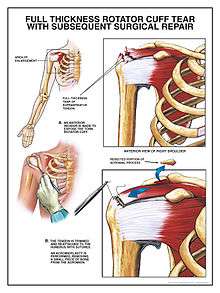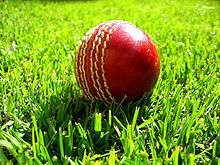Common injuries in cricket
Upper limb Injuries
Shoulder

The most common cause of shoulder injuries to cricketers is a result of fielding. Overuse of the shoulder when throwing repeatedly during fielding in a cricket game can lead to problems such as tendinitis in the biceps, a tear of the supraspinatus tendon or even degenerative changes to the rotator cuff which could result in a surgery to fix the tear.[1] Impingement, a syndrome that occurs when the rotator cuff muscles are inflamed or irritated, is a major injury risk that can develop amongst bowlers.[2] A 2001–2002 study focused on identifying a workload threshold that would avoid an increased risk in shoulder injuries. The study found that bowlers who produced an average of 123–188 deliveries per week were less likely to face injury whereas bowlers who averaged below 123 deliveries or above 188 deliveries per week were at a greater risk of causing injury.[3]
Elbow
Injuries to the Elbow are predominantly a result of poor techniques when both batting and bowling. Having a poor technique causes excess strain on the joint resulting in inflammation of the tendons surrounding the elbow. The inflammation can be treated through physiotherapy and rehabilitation to reduce the inflammation and strengthen the imbalance in the forearm.[1]
Hand
Majority of injuries sustained to the hands and wrists of a cricketer are impact injuries from the contact of the ball causing fractures, dislocations and sprains. Injuries to the fingers are the most common regarding the hand, and are often splinted and compressed to reduce swelling around the joint. Physiotherapy is essential to ensure the stiffness of the joint does not become too severe so that movement at the joint returns to normal.[1]
Back injuries

The most common injury location for most cricketers, more specifically bowlers, is the back. According to Stretch (1995), incidences of 33.3% for schoolboys and 17% of A-grade players most commonly suffer from back injuries.[4] Studied techniques of international bowlers who had a side-on action and a front-on action to determine which was a better option regarding the players back.[5] This study reached a solution that "an inability to achieve a side-on orientation during the delivery stride was the main cause of back injuries".[5] Pain in the lower back area is the most common problem that young bowlers face. When performing a bowling action continuously for long periods of time can place excess stress on the lower back muscle tissue which can then lead to serious stress fractures of the vertebra. These stress fractures can lead to a significant amount of time out of the game.[6]
Lower limb injuries
Knee
The most common injuries associated with the knee in cricket occur when a player is bowling. In the landing stride, bowlers are constantly twisting and putting extreme force through the knee joint, this can then result in a strain or more severely a tear to the collateral ligaments.[7] Patellar tendinopathy is a common knee injury that occurs most commonly in bowlers due to the overuse of the tendon which can lead to the tendon fibres beginning to break down.[8] David Lawrence, an English fast bowler is one particular example of how the landing stride when bowling can cause serious injuries to the knee. On 10 February 1992, his left patella shattered during a delivery.[9]
Foot/Ankle
Epidemiological studies looking at the most common injuries that affect fast bowlers found that 11% of injuries involve the foot and the ankle. Majority of the injuries to the feet and ankles of fast bowlers are a result of the impact of the foot planted in the delivery stride.[10] A bowler who's forefoot in their delivery stride is a plantar flex action can cause posterior impingement. After long durations this plantar flexion can lead to the creation of a bone spur which can then be treated through surgery.[11]
See also

Injury
References
- 1 2 3 Orchard, John; Press, Dove (1 January 2010). "Changes to injury profile (and recommended cricket injury definitions) based on the increased frequency of Twenty20 cricket matches". Open Access Journal of Sports Medicine: 63. doi:10.2147/oajsm.s9671.
- ↑ Hackney, R G (1 December 1996). "Advances in the understanding of throwing injuries of the shoulder.". British Journal of Sports Medicine. 30 (4): 282–288. doi:10.1136/bjsm.30.4.282. PMC 1332408
 . PMID 9015587.
. PMID 9015587. - ↑ "Bowling workload and the risk of injury in elite cricket fast bowlers". Journal of Science and Medicine in Sport. 6: 359–367. doi:10.1016/S1440-2440(03)80031-2. Retrieved 1 September 2015.
- ↑ Stretch, R (1995). "The seasonal incidence and nature of injuries in schoolboy cricketers". South African Medical Journal. 85: 1182–1184. PMID 8597012.
- 1 2 Elliot, B; Foster, D (1984). "A biomechanical analysis of the front-on and side-on fast bowling techniques". Journal of Human Movement Studies. 10: 83–94.
- ↑ Miller, J. "Cricket Injuries". physioworks.com.au. Retrieved 4 September 2015.
- ↑ Shafi, M (2014). "Cricket Injuries: an Orthopaedist's Perspective". Orthopaedic Surgery. Chinese Orthopaedic Association and Wiley Publishing Asia Pty Ltd. 6 (2): 90–94. doi:10.1111/os.12104.
- ↑ Peers, Koen H. E.; Lysens, Roeland J. J. (1 January 2005). "Patellar tendinopathy in athletes: current diagnostic and therapeutic recommendations". Sports Medicine (Auckland, N.Z.). 35 (1): 71–87. doi:10.2165/00007256-200535010-00006. PMID 15651914.
- ↑ "David Lawrence's Test career ends with horrific injury as spectators hear a spine-chilling crack and an agonising scream". Retrieved 1 September 2015.
- ↑ Hurrion, P. D.; Dyson, R.; Hale, T. (1 December 2000). "Simultaneous measurement of back and front foot ground reaction forces during the same delivery stride of the fast-medium bowler". Journal of Sports Sciences. 18 (12): 993–997. doi:10.1080/026404100446793. PMID 11138989.
- ↑ Spratford, Wayne; Hicks, Amy (28 February 2014). "Increased delivery stride length places greater loads on the ankle joint in elite male cricket fast bowlers". Journal of Sports Sciences. 32 (12): 1101–1109. doi:10.1080/02640414.2014.886130.